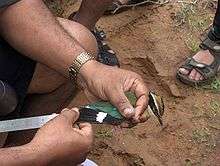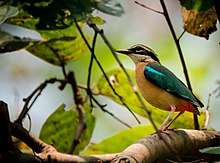Indian pitta
| Indian pitta | |
|---|---|
_Photograph_by_Shantanu_Kuveskar.jpg) | |
| Pitta brachyura from Mangaon, Maharashtra, India | |
| Scientific classification | |
| Kingdom: | Animalia |
| Phylum: | Chordata |
| Class: | Aves |
| Order: | Passeriformes |
| Family: | Pittidae |
| Genus: | Pitta |
| Species: | P. brachyura |
| Binomial name | |
| Pitta brachyura (Linnaeus, 1766) | |
| Synonyms | |
|
Corvus brachyurus[2] | |
The Indian pitta (Pitta brachyura) is a passerine bird native to the Indian subcontinent. It inhabits scrub jungle, deciduous and dense evergreen forest. Breeding in the forests of the Himalayas, hills of central and western India, they migrate to other parts of the peninsula in winter. Although very colourful, they are usually shy and hidden in the undergrowth where they hop and pick insects on the forest floor. They have a distinctive two note whistling call which may be heard at dawn and dusk.[3] It is considered Least Concern by IUCN as its range is very large.[1]
Characteristics

The Indian pitta is a small stubby-tailed bird that is mostly seen on the floor of forests or under dense undergrowth, foraging on insects in leaf litter. It has long, strong legs, a very short tail and stout bill, with a buff coloured crown stripe, black coronal stripes, a thick black eye stripe and white throat and neck. The upperparts are green, with a blue tail, the underparts buff, with bright red on the lower belly and vent. The bird hops on the ground to forage and has been known to get trapped in ground traps meant for small mammals.[4] It has been suggested that the width of the coronal stripe may differ in the sexes.[5]
It is more often heard than seen and has a distinctive loud two-note whistle wheeet-tieu or wieet-pyou or sometimes, a triple note hh-wit-wiyu. They have a habit of calling once or twice, often with neighbouring individuals joining in, at dawn or dusk leading to their common name of "Six-O-Clock" bird in Tamil.[6] When calling the head is thrown back and the bill is pointed upwards.[7]
Pittas are among the few Old World suboscine birds. The Indian pitta is the basal member of a distinct clade that includes many of the Oriental species.[8] It forms a superspecies with the fairy pitta (P. nympha), mangrove pitta (P. megarhyncha) and blue-winged pitta (P. moluccensis).[9]
Etymology

The name pitta comes from the Telugu word meaning "small bird".[7] Local names in India are based on the colours and their behaviours such as the time of calling and these include Hindi: Naorang, Punjabi: Nauranga (=Nine colours), Bengali: Shumcha, Cachar: Dao bui yegashi, Gujarati: Navaranga or Hariyo; Tamil: Aru-mani kuruvi (=6-O'Clock bird), Kathelachi, Thotta kallan; Telugu: Polanki pitta, Ponnangi pitta; Malayalam: Kavi; Kannada: Navaranga and Sinhalese: Avichchiya.[10] The Sinhalese interpretation of its call is that the bird is complaining about the theft of its dress by a peacock: “Evith giya, evith giya, ayith kiyannam, methe budun buduwana vita ayith kiyannam,” which translates as: “Came and went! Came and went! I’ll still be complaining when the next Buddha comes! I’ll still be complaining!”[11]
Distribution

Indian pittas breed mainly in the Himalayan foothills from the Margalla hills northern Pakistan in the west[12] to at least Nepal and possibly up to Sikkim in the east. They also breed in the hills of central India and in the Western Ghats south to Karnataka.[13][14] They migrate to all parts of peninsular India and Sri Lanka in winter. Exhausted birds may turn up inside homes.[7] They are rare in the drier regions of India.[15]
Ecology and behaviour

Indian pittas roost in trees.[13] They feed on insects and other small invertebrates that they usually pick up from the ground or leaf litter. They have also been noted to take kitchen food scraps from the ground.[16]
They breed during the south-west monsoon from June to August, with peaks in June in central India, and in July in northern India.[17] The nest is a globular structure with a circular opening on one side built on the ground or on low branches. It is made up of dry leaves and grasses. The clutch is four to five eggs which are very glossy white and spherical with spots and speckles of deep maroon or purple.[7][13]
Avian malaria parasites have been noted in the species.[18] Five out of thirteen birds in an ectoparasite survey were found to have the tick, Haemaphysalis spinigera.[19]
Their seasonal movements associated with the rains have not been well studied.[3]
References
- 1 2 BirdLife International (2012). "Pitta brachyura". IUCN Red List of Threatened Species. Version 2014.3. International Union for Conservation of Nature.
- ↑ Dickinson, E.C.; R.W.R.J. Dekker; S. Eck & S. Somadikarta (2000). "Systematic notes on Asian birds. 5. Types of the Pittidae" (PDF). Zool. Verh. Leiden. 331: 101–119.
- 1 2 Ali, S.; S. D. Ripley (1983). Handbook of the birds of India and Pakistan. 4 (2nd ed.). Oxford University Press. pp. 252–253.
- ↑ Prabhakar, A. (1998). "An Indian Pitta (Pitta brachyura) trapped in a standard Sherman live trap". Journal of the Bombay Natural History Society. 95 (1): 114–115.
- ↑ Harper, E. W. (1902). "The sex of the Bengal pitta Pitta brachyura". Avicultural Magazine. 1 (1): 29.
- ↑ Lambert, F. (1996). "Identification of pittas in the brachyura complex in Asia". OBC Bull. 23: 31–37.
- 1 2 3 4 Whistler, H. (1949). Popular Handbook of Indian Birds (4th ed.). Gurney and Jackson. pp. 275–277.
- ↑ Irestedt, M.; Ohlson, J. I.; Zuccon, D.; Källersjö, M. & Ericson, P. G. P. (2006). "Nuclear DNA from old collections of avian study skins reveals the evolutionary history of the Old World suboscines (Aves: Passeriformes)" (PDF). Zoologica Scripta. 35 (6): 567–580. doi:10.1111/j.1463-6409.2006.00249.x.
- ↑ Wells, D. R. (2007). The Birds of the Thai-Malay Peninsula, Volume 2. London, UK: Christopher Helm. p. 72. ISBN 978-0-7136-6534-5.
- ↑ Anonymous (1998). "Vernacular Names of the Birds of the Indian Subcontinent" (PDF). Buceros. 3 (1): 53–109.
- ↑ Bandara, C. M. Madduma (2009). "Exploring the link between culture and biodiversity in Sri Lanka". SANSAI : an Environmental Journal for the Global Community. 4: 1–23. hdl:2433/110021.
- ↑ Islam, K. (1978). "Sighting of the Indian Pitta (Pitta brachyura) in Pakistan". Journal of the Bombay Natural History Society. 75 (3): 924–925.
- 1 2 3 Rasmussen, P. C.; J. C. Anderton (2005). Birds of South Asia: The Ripley Guide. Smithsonian Institution and Lynx Edicions. pp. 295–296.
- ↑ Pande, S. A. (2001). "The Nesting of Pitta brachyura in the Konkan Maharashtra". Newsletter for Birdwatchers. 41 (4): 48–49.
- ↑ Singh, H. (2004). "Indian Pitta Pitta brachyura in the Thar Desert". Journal of the Bombay Natural History Society. 101 (2): 319–320.
- ↑ Devasahayam, S.; Devasahayam, A. (1989). "A note on the food habits of the Indian Pitta". Newsletter for Birdwatchers. 29 (5&6): 8.
- ↑ Bentham, R. M. (1922). "Breeding of the Indian Pitta Pitta brachyura and the Streaked Wren-Warbler Prinia lepida". Journal of the Bombay Natural History Society. 28 (4): 1135.
- ↑ Valkiunas, G.; M. A. Pierce (2000). "The status of Plasmodium corradettii Laird, 1998 (Haemosporida: Plasmodiidae): a malarial parasite of birds". Systematic Parasitology. 45 (2): 141–143. PMID 10743858. doi:10.1023/A:1006271710771.
- ↑ Rajagopalan, P. K. (1972). "Ixodid Ticks (Acarina: Ixodidae) parasitizing wild birds in the Kyasanur forest disease area of Shimoga District, Mysore State, India". Journal of the Bombay Natural History Society. 69 (1): 55–78.
Other sources
- Donald, C. H. (1918). "The occurrence of the Indian Pitta Pitta brachyura in the Kangra District, Punjab". Journal of the Bombay Natural History Society. 25 (3): 497–499.
- Ingalhalikar, S. (1977). Indian Pitta in captivity. Newsletter for Birdwatchers 17 (7): 8–9.
- Bolster, R. C. (1921). Breeding of the Indian Pitta. Journal of the Bombay Natural History Society 28 (1): 284.
